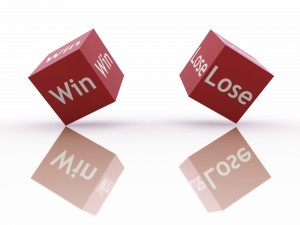 I’m going to make the case that you can’t afford not to gamble.
I’m going to make the case that you can’t afford not to gamble.
Let’s start with some not so simple statistics (I promise this won’t hurt). Let’s assume we’re playing a game that has 1% chance to win $1,500 and costs $10 to play. If your budget is $1,000 your chances to win at least once are 73% (sorry, it’s not as simple as 100/100). Those aren’t great risk/reward options – $365 of upside versus $270 of downside. But what happens if the cost of the game drops to $1? Then your odds of winning at least once are 99.9%, so you’re looking at $499 of upside and $1 of downside. Now let’s add a another wrinkle to this story. What if I told that if you there was a better than 50% chance you’d lose your $1,000 even if you didn’t play?
Another way to look at this would be to compare the cost of 99.9% success rate. In the three scenarios above, those costs are $10,000, $1,000, and $10 respectively. How much of a no-brainer is it to spend $10 with a 99% probability of winning $1,500?
Cost of Failure
The first point I’m driving at here is that as the cost of failure approaches zero and the reward stays constant, at some point it ceases to be gambling and becomes something that simply can’t lose. I’m writing about this today because I’m reading the book Groundswell and this concept has been bugging me throughout the book. Since the authors are market researchers, I suppose it’s no surprise that they constantly harp on the need to carefully segment your target social media market (something they call “technographics“) and properly target your strategy accordingly. They would have you determine, for example, whether your audience is composed predominately of “critics,” “creators,” “joiners,” or various other categories. Once you’ve determined this, you can then proceed with deciding the best social media strategy and tools to employ.
[iframe http://www.forrester.com/groundswell/b2c_profile_tool/b2c 530 380]
The only problem with this approach is that it assumes a high cost of failure, which is not necessarily the case with the wide variety of low and no cost platforms available in our Web 2.0 economy. Having said that, the book went a long way toward redeeming itself near the very end by encouraging companies not focus on the possibility of failure, but the cost of missed opportunities. “To do this, companies need to be ready to fail often, fail quickly, and most importantly, fail cheaply.”
Cost of Not Winning
If that argument is not compelling enough, then consider the final wrinkle to my original allegory. Why not just play it safe? If you never try, you never win, but you also never lose. Right? That’s true as long as your competitors and/or market don’t change the rules of the game on you. There is a risk to not adapting or innovating that frequently inflicts more damaging, if not lethal consequences.
You need to consider the cost of failure before dismissing particular approaches or needlessly investing in research that, at the end of the day, may cost more than failing. And just as importantly, consider the potential cost of doing nothing at all.